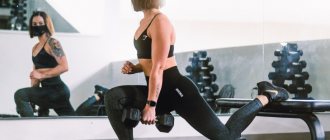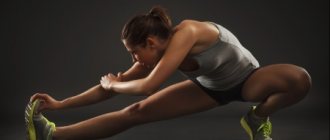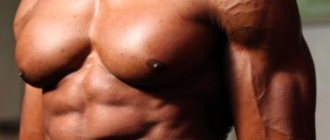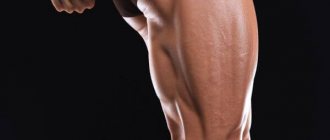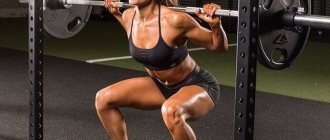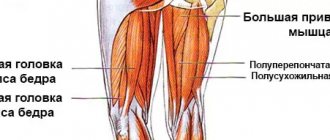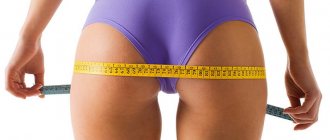Hamstring muscles[edit | edit code]
Anatomy[edit | edit code]
Hamstring muscles
- M. biceps femoris (biceps femoris)'
. The long head is attached to the tubercle of the ischium, the short one to the lateral lip. This muscle helps in straightening the leg, flexes the shin and rotates it outward in a bent knee joint. - M. semitendinosus (semitendinosus muscle)
. It is attached to the side of the tibial roughness on the pes anserinus. Responsible for straightening the thigh of the supporting leg, bending the ankle joint and rotating the bent shin inward. - M. semimembranosus (semimembranosus muscle)
. Attached to the medial articular condyle of the tibia. Its functionality is the same as that of the semitendinosus.
Biomechanics[edit | edit code]
The hamstrings are the type of muscle that shortens more often. With the help of a simple exercise you can diagnose your existing shortening. The ability to stretch is considered sufficient if you can, while lying on your back, raise your leg 90 degrees up and fix it in this position without any pain. If you can’t do this, then you should work on stretching. The back surface of the thigh receives the main load when running, specifically when sprinting. This is why athletes involved in straight running and steeplechase often suffer sprains and tears in the biceps muscle.
Also, danger lies in the uneven development of the muscles of the front and back of the thigh. This often happens due to past participation in any sports. You can be sure that your balance is shifted towards the quadriceps if you often play football or do jumping. Conversely, your hamstrings are stronger if you run short distances. Naturally, imbalance can also be caused in the gym. To do this, squat for a long time with your legs wide and below parallel.
In case of imbalance, it is useful to perform some restoration work using unusual exercises, which will be discussed below. Experience shows that in basic exercises it is worth using a moderate number of repetitions per set (8-10).
Now let's talk about exercises that can bring maximum benefit to the muscle group in question.
Diagnostics
Making a correct diagnosis is the key to effective and high-quality treatment. Therefore, there is a certain examination algorithm, the scope of which can be determined by the doctor. The patient's diagnostic path consists of the following steps:
1. Consultative examination and history taking.
2. Manual muscle testing, assessment of motor stereotypes, identification of violations of the biomechanical chain of the musculoskeletal system.
3.Performance of specific tests and samples by the patient
4.Complete additional laboratory and instrumental research methods: general and biochemical blood tests, laboratory tests for specific markers, radiography, ultrasound, electroneuromyography, MRI, MSCT.
- Consultation with doctors of related specialties to verify differential diagnosis.
This scope of diagnostics makes it possible to accurately determine the pathology and cause that caused the pain, since pain in the hip, buttock, and groin area can have different etiological factors. A well-constructed diagnostic strategy allows the doctor to prescribe the necessary range of therapeutic measures in a short time.
Exercises[edit | edit code]
- Deadlift
- Squats
- Leg press
- Bend legs in the machine
- Posterior thigh muscle stretch
Deadlift on straight legs[edit | edit code]
The deadlift is one of the best exercises for developing the hamstrings. However, if these muscles are significantly behind in development or you are recovering from an injury, then you need to modify this exercise a little. Now this will be a straight leg deadlift with dumbbells. You heard right: you need to stand on one leg! Dumbbells in lowered hands, free leg goes back. Obviously, you cannot use heavy weights in this exercise, therefore, perform 15-20 repetitions per set.
Squats[edit | edit code]
Barbell squats can and should be performed with a wide stance. You should sit down almost until your gluteal muscles touch the floor. It should be noted that this manner will lead to very rapid growth of not only the hamstrings, but also the gluteal muscle. And hypertrophied buttocks don’t look very good. Especially for men. A much more gentle option is squats with dumbbells in your hands. This option allows you to focus the load on the thigh biceps.
Leg press[edit | edit code]
The leg press in the simulator is an exercise that can be finely adjusted to suit you. If your target is the biceps femoris, then place your feet closer to the top edge of the platform. The distance between the feet is about 35-45 cm. The lower part of the amplitude is important here. Also try to rest on your heels rather than on your entire foot.
Leg curls in the simulator[edit | edit code]
The leg curl machine will also not be forgotten. I recommend performing the movement with each leg in turn - this will allow you to more fully concentrate on the work of the target muscles. At the bottom, the joint does not fully extend; at the top, throw your leg until it touches.
Stretching[edit | edit code]
Stretching plays a big role in developing the hamstrings and preventing injury. Since the target region is very large, some effort must be made to achieve adequate stretching. But there is no need to “tear” the muscle—it is enough to calmly and measuredly increase the amplitude of movement. In addition to the option when you lie on your back and stretch your leg raised at an angle of 90 degrees, you should use deep lunges. Bring your leg forward and sit on it. Ideally, you should be able to touch your chest to your knee. Let us remind you that before training you need to do dynamic stretching, but after training, when the muscle is in a stretched state, it remains for up to 15 seconds. Please note that the stretched muscle should not be strained. This leads to pain and even more stress. Try to breathe calmly and shallowly, then you will be able to catch the moment when the muscle stretches, but does not instinctively tense. It is when working on the back of the thigh that you can feel this best. Following these simple recommendations will allow you to move an unyielding muscle, reduce imbalance in development, and prepare it for more stressful loads.
Source Iron World No. 3
Treatment
Help before diagnosis
In case of traumatic injuries, ensure limb rest. In case of fractures, the leg is fixed using two splints: the inner one from the foot to the groin, the outer one to the armpit. Cold is applied to the leg, in case of severe injuries, painkillers are administered, and anti-shock measures are carried out according to indications. The severity of symptoms of myositis and tendonitis is reduced with the help of anti-inflammatory, analgesic gels and ointments. Sharp pain, significant swelling, and problems with general condition are reasons to immediately consult a doctor.
Conservative therapy
Patients with fractures are given blockades, the hip is fixed using skeletal traction, which is replaced with a plaster cast after clinical and radiological signs of fusion appear. Treatment tactics for other lesions are determined based on the nature of the disease. Conservative treatment of most hip pathologies includes:
- Protective mode.
The mode of physical activity is chosen taking into account the type and severity of the disease. Fixation with a plaster splint, the use of splints, crutches or a cane are possible. - Therapeutic exercise.
To maintain muscle strength and joint mobility, prevent complications and improve general condition, individually selected exercise therapy complexes are prescribed. - Physiotherapeutic procedures.
UHF, electrophoresis, laser therapy and other techniques are used to reduce pain, accelerate resorption, improve blood circulation and tissue nutrition, and stimulate healing.
The listed activities are supplemented with massage, sometimes with manual therapy and taping. For purulent diseases, antibiotics are prescribed, for inflammatory pathologies - NSAIDs, for neurological lesions, blockades are performed.
Thigh taping
Bottom line
Exercises for the back of the thigh are capturing the minds and hearts of women more and more every day. And remember that if you want to get an ideal figure, you don’t have to run to the gym. You can organize training at home, fortunately there are special exercises that allow you to work your legs and hips without using heavy barbells. Combine and maintain a balance between all muscle groups, and by summer you will have something to show off on the beach.
Read also: Exercises for arm strength
The investigation is being conducted by a vertebrologist
The first and most important part of the diagnosis is interviewing the patient. For example, if a patient told the doctor: “My buttock hurts when I sit,” then the sciatic nerve is probably to blame. If the patient has not had injuries to the hip, pelvis, coccyx area, or unsuccessful intramuscular injections, the doctor will suggest sciatica - pinching of the sciatic nerve somewhere between the 4th lumbar vertebra and the sore spot. The most common culprit is a spasm of the piriformis muscle, through which this nerve passes. But it happens that problems are associated with the 5th lumbar or the first three sacral vertebrae, the hip joint, tumors, or even changes in the pelvic area during pregnancy (including early stages). The same diagnostic algorithms are available for pinched other nerves.
The doctor then examines the patient. He determines which muscles are tight, how the patient reacts when certain points are pressed, and conducts standard neurological tests. Next, an examination is scheduled. Depending on the results of the survey and examination, the following may be prescribed:
- x-ray in two projections;
- computed tomography (CT);
- magnetic resonance imaging (MRI).
Usually they start with an x-ray. A CT scan will be needed if there is a suspicion of a fracture, and an MRI will be needed if it is necessary to exclude herniated discs or changes in soft tissues. Additional studies - blood tests, electrocardiogram, ultrasound and others - are prescribed if the doctor suspects non-neurological causes of pain or wants to make sure there are no contraindications to certain prescriptions.
Exercise No. 5. "Shell"
- Place the band on your legs just above or below your knees. Lie on your side, resting on your forearm, as in a side plank.
- The legs are slightly bent and lie on top of each other.
- Raise your top knee while keeping your feet together.
- Pause for a few seconds at the top and slowly lower your knee to the starting position.
- Perform the movement in a controlled manner and watch for tension in the muscles of the thighs and buttocks.
For beginners, it is better to start doing the exercise with a fitness band with minimal resistance.
Perform 10-15 repetitions on each leg.
Deadlift
One of the most effective basic loads for the hamstring muscles. The front of the legs and the torso of the back are also involved. Also remember that this row is one of the best movements for lifting the buttocks.
about the difference between “Deadlift” and “Romanian” for girls here.
Implementation complexity is medium. Concentration and endurance are required. It is better to use dumbbells or a barbell of a comfortable weight from the equipment.
Technique:
- Starting position – feet shoulder-width apart, knees slightly bent, back straight, arched in the lower back, weights in the hands in the groin area;
- Inhaling, bend at the back, hands with weights slide along the body to the middle of the shin;
- Without stopping at the bottom point, we exhale and return to the starting position.
Watch the video for more details:
You should try to push off from the bottom point with the biceps and the muscles leading to it. If you don’t feel the area being trained, all your efforts are in vain.
Deadlifts should be performed in 3-4 sets of 6-10 times.
Carefully! The dumbbells or barbell must move strictly along the body. The farther the bar is from the body, the greater the negative load on the spine and the chance of injury.
What is a fitness elastic band and how to choose it?
Fitness bands, also known as expanders, are special elastic bands that serve as an excellent alternative to weights in home and gym workouts. Their advantage lies in their low cost, versatility and flexibility of use.
Most tapes are color-coded or letter-coded (S to XXL) according to tension level. The less elasticity, the more resistance the muscles receive. The gradation in most cases is as follows:
- Ribbons in yellow, green, and orange colors are suitable for beginners. The load ranges from 2 to 5 kg.
- Red ribbons are considered a universal option. The fitness elastic band provides a load of 5 to 8 kg.
- Blue color is great for working out the legs and buttocks. The band provides a load of 12 to 18 kg, so it is suitable for those who have training experience.
- Black color provides a load of 19 to 30 kg. Ideal for experienced athletes.
It is recommended to have different versions of expanders, since different muscle groups require individual loads. The favorites of many athletes are the following manufacturers of fitness bands: SPRI, Fit Simplify, Insonder, BodyBoss 2.0 Full Portable Home Gym.
The service life of expanders depends on the way they are used and stored. If you do this incorrectly (do not hide from direct sunlight, dry on a radiator, etc.), they may crack, lose elasticity or weaken prematurely. In other cases, the period of use is practically unlimited.
Is it necessary to do it?
Again, there are often conflicting opinions in the gym about performing hamstring exercises, as they believe that the potential harm far outweighs the benefits of this type of exercise. And yet, working with legs is:
- a basic complex that stimulates the body to massive anabolism,
- a great opportunity to get rid of the “orange peel”,
- improved functionality. Now walking in heels will not bring such inconvenience as before,
- a necessary complex to create a balanced figure.
Benefit
And yet, recently, exercises for the back of the thigh and buttocks have gained extraordinary popularity among all representatives of the fair sex. It's all the fault of the Kardashian family, who, with their twerks and impressive forms, set new standards of beauty that all representatives of the fair sex strive for. But is everything so good? Yes, first of all, exercises for the back of the thigh are a necessity. Why? Because they use those muscles that are used very little during everyday life. In particular, the hamstrings are used exclusively when a person tries to sit on a chair or bend over. That is why unathletic girls may have a beautiful butt, but its outline will still be blurry due to the underdeveloped back of the thigh.
Harm and possible contraindications
But is everything so good, is there any potential harm from using exercise for the back of the thighs? There is no potential harm at all.
You can harm your body only if you do not perform the exercises properly.
But there is also a risk of improper loading of the back of the thigh. This is expressed when women begin to become overly involved in basic exercises. Therefore, when working the back of the thigh, you need to take into account the following feature:
- A month of training in heavy basic exercises (to create a basic muscle group on which a further figure will be built).
- 3 months of split, in which isolation exercises will prevail over basic ones.
- Reducing working weights from the 5th month, with an increase in the number of approaches and repetitions.
When you have reached your optimal figure, you should think about reducing the load even more in order to just maintain the muscle group in good shape. As for contraindications, they are standard:
- presence of spinal injuries,
- problems with bones, blood vessels, ligaments, veins,
- the presence of tumors in the abdomen,
- pregnancy,
- kyphoscoliosis, lordoscoliosis and simply scoliosis.
Read also: Power plate: vibration will help you lose weight
Why does the spine play an important role? Because almost all exercises with free weights require massive output from the muscular corset, due to the presence of a vertical compressive load, due to which, in the presence of curvatures, the latter can greatly increase and even lead to disability.
Otherwise, working with the muscles of the thigh and buttocks has no special contraindications.
Four ways to help
Let's figure out how to treat pain in the buttock that radiates to the leg if it is determined that the disease is associated with the spine or muscles. There are several ways to help such patients.
- Drug therapy is usually used in the early stages and includes the prescription of vitamins, microelements, medications that relieve muscle spasms, and anti-inflammatory and painkillers. Unfortunately, ointments, tablets and injections most often cannot cure a patient, but in the first stages they help relieve an acute condition.
- Physiotherapy - the use of electromagnetic fields (magnetotherapy) and weak currents (electrophoresis) are considered the main methods, although other procedures are also possible. Their goal is to relax muscles and relieve inflammation.
- Massage, manual therapy and osteopathy are the three main methods of treatment. This is not only about relaxing muscles and restoring blood flow. With the help of these methods, it is possible to correct your posture, and this reduces the likelihood of relapse of the disease.
- Movement treatment: physical therapy, special rehabilitation complexes on suspension systems help consolidate the result and give the back and abdominal muscles the strength necessary to keep the spine in the correct position.
There is no universal treatment for pain in the buttock that radiates to the leg. The doctor prescribes treatment individually. Good news for pregnant women who often suffer from back pain: there are effective ways to treat their spine and joints for them too.
